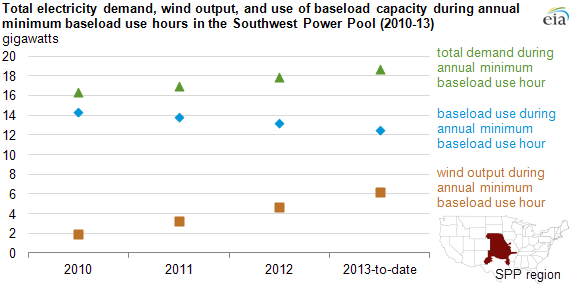The Energy Information Administration’s “Today in Energy” series shows with a couple of charts how growing wind power output in the Southwest Power Pool region is cutting into the income of baseload power plants.

The effect matters because baseload power plants tend to have the lowest operating costs. As baseload plants get pushed off the system, more of system capacity will shift to more flexible “load following” plants, which tend to have higher operating costs. Power prices in the Southwest Power Pool and other ISO power markets tend to reflect the operating costs of load following plants, so the effect will be to increase average wholesale power prices.
Wind power advocates sometimes want to claim credit for driving down power prices, and in the short run the addition of wind power can push prices down (especially, of course, if wind power plants have their output subsidized as with the Production Tax Credit). In the long run, as output of cheap-to-run baseload power plants is squeezed from the system, average prices will rise again.
The ERCOT market in Texas faces this same problem — in fact I suspect it is a little further down this path than the Southwest Power Pool — and the state has been struggling over projected resource adequacy concerns on the horizon. Of course, as Texas PUC commission Kenneth Anderson has pointed out, an efficient “energy-only” market with growing consumption should always see resource adequacy problems about four or five years ahead. If it doesn’t see shortages in the future, it implies the system is currently overbuilt. Still, incentives to invest in generation appear weak, wind power capacity additions in Texas are expected to continue, and resource adequacy analysts in ERCOT are nervous.
Michael,
Is it worth noting that these baseload plants look cheap from a variable cost perspective but may not in fact be so cheap from a societal welfare perspective? In particular, they impose, as compared to wind, substantial health costs on people through their emissions of SO2, NOx, and PM, and ozone (I ignore GHGs because those costs are more controversial). Moreover, the requirement that many of these plants in the SPP must now install additional controls to meet new EPA regs combined with the coal-gas fuel price differential means that prices are going up for reasons having nothing to do with wind capacity.
Power prices are changing in places that have long relied on coal, especially when those coal units have been run without emissions controls or with locally sourced high sulfur coals whether more wind gets built or not. And even if we pay a few cents more on the power bill, if our bill for childhood asthma goes down, it might be a good trade.
Best,
Michael
Agreed. “Cheap operating costs” from the point of view of the owner, but there may be external costs. Note that baseload power plants being squeezed by low prices include both nuclear and coal plants, technologies with quite different potentials for external costs, and subsidies for wind power generation bear almost no relationship to any externalities mitigated.
The EIA short points to one ‘annual minimum baseload hours’ a year (3-4 A.M.-ish.) This is a picture of the corner case being affected…so it’s cheery to see wind being of service while the baseload plants get their refineries and scrubbers serviced, and the rods get changed…and it takes 2 months (with the other maintenance, typically) they say. ‘Heart!’ and coordinating maintenance on that baseload minimum still trump wind for mad credit freeing up upgrade/test schedule spots, but that is 6GW you (where ‘you’ want to power a SPPish region) do not have to have in the form of an hour’s worth of steam superheated and loading some hot-side materials. Bunches of wind and/or gyro storage…
Reblogged this on SMIPP Ltd..
This report doesn’t appear to actually be describing the data that the headline talks about. There are two problems I see.
A) they aren’t actually measuring baseload generation, just minimum demand minus wind. Given that the dates they specify are in April, I’m guessing some baseload gen is in outage
B) They have selected a single hour to measure. If these wind farms (SPP wide) have a capacity factor in the 30%-40% range, the results analysis could turn on a dime if the low load hour happened to fall on a good vs bad wind hour. Which seems to be occurring in this report. 2010 cf = 2gw / 3.4gw = 60% … 2013 cf = 6gw / 6.8gw = 88%
Now, I’m inclined to agree with their findings even though I think their approach is weak. I’d even bet that you’d see similar problems in north western MISO as well.
If I were to try and determine if baseload gen was being displaced I think I would use relative capacity factors. But even then you’d still be stuck trying to isolate the impact of changing fuel costs… Hmm… Tough problem indeed
Last thought. If you use the 2010 capacity factor for 2013 the numbers tell a different story. The 6gw of wind gen goes to 4gw with a 60% cf. Which means the “baseload” portion goes to just over 14gw… Which is about the same volume as 2010. Which would imply no change over the past few years